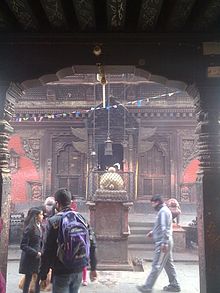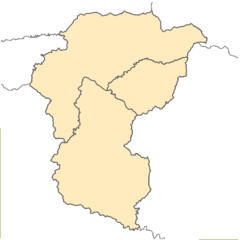Kumbheshwar Temple
This article needs additional citations for verification. (December 2016) |
| Kumbheshwar Temple | |
|---|---|
कुम्भेश्वर मन्दिर | |
 Kumbheshwar Temple | |
| Religion | |
| Affiliation | Hinduism |
| District | Lalitpur |
| Deity | Shiva |
| Festivals | Janai Purnima, Shivaratri, Teej, Bala Chaturdashi etc. |
| Location | |
| Location | Kathmandu |
| State | Bagmati |
| Country | Nepal |
 Location in Kathmandu | |
| Geographic coordinates | 27°40′36″N 85°19′33″E / 27.67667°N 85.32583°ECoordinates: 27°40′36″N 85°19′33″E / 27.67667°N 85.32583°E |
| Architecture | |
| Type | Pagoda |
| Creator | King Jayasthiti Malla |
| Completed | 1392 |
| Specifications | |
| Temple(s) | 3 |
| Monument(s) | 5 |
| Part of a series on |
| Hinduism |
|---|
 |
|
|
Kumbheshwar Temple (Nepali: कुम्भेश्वर मन्दिर) is one of the oldest Hindu temples, situated 200m from the northern part of Patan Durbar Square. It was built in the 14th century (around 1392) by King Jayasthiti Malla that makes it the oldest temple in Patan. It is one of the two free-standing five-storied temples, the other being the famous Nyatapola temple of Bhaktapur. The temple is noted for its graceful proportions and fine woodcarvings and is dedicated to Shiva, as indicated by the large Nandi, or bull, facing the temple.[1]
Temple complex[]
The Kumbheshwar Temple lies in a complex that includes many other structures: Bagalamukhi (बगलामुखी मन्दिर), Ulmanta Bhairava (उल्मान्त भैरव) and two hiti ponds among the most notable ones. It is a popular belief that the water spring that fills the ponds originates all the way from Gosainkunda, which is located 43 kilometers north of Kathmandu. So taking a dip in the pond during the festival Janai Purnima (जनै पुर्णिमा) is equivalent to doing the same in Gosainkunda.[2] Shiva’s mount, the bull Nandi is kneeling in front of the main Kumbheshwor Temple. High above the wooden roof tiers look as if they might topple over on this five-story building.
How Patan (Lalitpur) got its name from Kumbheshwar[]
The story goes that a farmer with leprosy from Kathmandu came here because the grass was better for his cow. One day he struck his wooden pole into the ground and discovered a water source. That evening on his way back he saw the king passing by. He stepped off the road as was the custom for someone with leprosy. The king, however, saw no trace of the disease. Indeed the king found the man so handsome that he gave him a new name "Lalit" (ललित) or handsome. The king knew a miracle had occurred and asked Lalit what happened. Lalit showed the king where he found the water source and the king pronounced that a hiti (हिटी) (meaning tap) should be placed there. Thus, the place was called Lalitpur (ललितपुर) (meaning the land of fine arts and fine people). Another story tells of a man who lost his water vessel on a pilgrimage who found it again at the Kumbheshwar. The word Kumbha in Kumbheshwar means "water vessel". Whether any of the above is anything more than legend is up for debate. The fact that there is a water source from the Himalayan mountains (Gosainkunda) at Kumbheshwar may yet be another contributing factor. Perhaps Patan got its name from all of the above combined. [3]
Gallery[]
Images of Bangalamukhi Temple, situated inside the complex.

Five storey pagoda style Kumbheshwor Temple

Temple with sattal, Misha Hiti, Konti Hiti and Kumbheshwar Pokhari

Sattal that serves as main entrance

Sattal that serves as main entrance

References[]
- ^ "Kumbheshwor Temple, Kathmandu - Patan". Radha.name. Retrieved 2016-12-31.
- ^ Water Conduits in the Kathmandu Valley (2 vols.) by Raimund O.A. Becker-Ritterspach, ISBN 9788121506908, Published by Munshiram Manoharlal Publishers Pvt. Ltd., New Delhi, India, 1995
- ^ "Kumbeshwar Temple Complex in Patan City". Thelongestwayhome.com. 2016-06-20. Retrieved 2016-12-31.
- Patan Durbar Square
- Hindu temples in Lalitpur District, Nepal
- 14th-century establishments in Nepal





